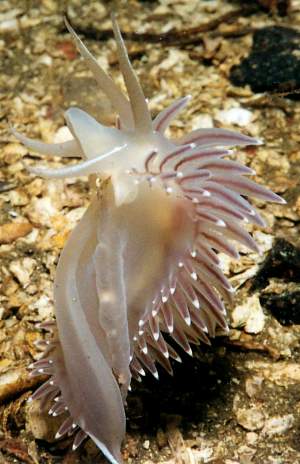
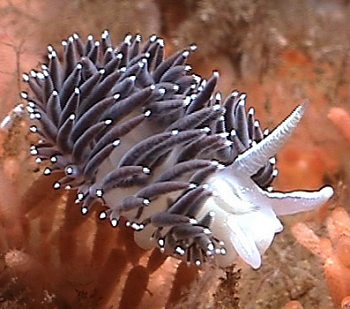
Flabellina trophina
(Bergh, 1894)
Order: NUDIBRANCHIA
Suborder: AEOLIDINA
Family: Flabellinidae
PHOTO
Upper: Bear Cove, Port Hardy, British Columbia, Canada. Depth: 30-40'. February 9th.Photo: Glen Miller. Lower: Coronation Island in Alaska at about 10m. July 2002. Size was maybe 50mm Photo: Clinton Bauder.
The body and cerata are translucent white, with the ceratal digestive gland duct ranging in colour [pink, dark brown, dark grey]. The cerata are capped with opaque white and both the rhinophores and oral tentacles have a white line running up their posterior sides. There is also a white line on the posterior tip of the foot which bifurcates, each branch ending near the posterior cerata. The slender rhinophores are perfoliate with up to 38 shallow leaves. Irina Roginskaya discusses the nomenclatural history of this species in an attached message. It was previously known on the Forum as Flabellina fusca, O'Donoghue, 1921. Studies on its natural history suggest that as well as feeding on hydroids such as Bougainvillia and Obelia it also feeds on other nudibranchs, crustacea and polychaete worms [see message].
Reference:
• Bergh, L.S.R. (1894) Reports on the dredging operations off the west coast of Central America to the Galapagos, to the west coast of Mexico, and in the Gulf of California, in charge of Alexander Agassiz, carried on by the U. S. Fish Commission steamer "Albatross", during 1891, Lieut. Commander Z. L. Tanner, U.S.N. commanding. 13. Die Opisthobranchien. Bulletin of the Museum of Comparative Zoology, Harvard, 25(10): 125-233,Pls. 1-12.
• Bergh, L.S.R., 1879. On the nudibranchiate gastropod Mollusca of the North Pacific Ocean, with special results of those of Alaska. Sci.Results of the Exploration of Alaska. I, (5): 127-135.
• O'Donoghue, C.H. (1921). Nudibranchiate mollusca from the Vancouver Island region. Transactions of the Royal Canadian Institute, Toronto, 13(1): 147-209
• Roginskaya, I. S. (1986) Reader forum [Coryphella trophina]. Shells & Sea Life, 18(1): 17-18.
• Roginskaya, I. S. (1964) A large-sized nudibranch mollusc Coryphella fusca, O'Donoghue -- predator of small nudibranch molluscs -- Coryphella rufibranchialis Johnston and Cuthona sp. Zoologicheskii Zhurnal, 43(11): 1717-1719. [In Russian].
• Roginskaya, I. S. (1969) Taxonomy and ecology of the nudibranch mollusc Coryphella fusca. Zoologicheskii Zhurnal, 48: 1614-1617.
• Roginskaya, I. S. (1990) Data of feeding, distribution and synonymy of Coryphella trophina (Bergh, 1894) (Nudibranchia: Gastropoda), pp. 47-57, 151-152, 156. In: A. P. Kuznetsov, [Ed.], Feeding and bioenergetics of marine bottom invertebrates. Academy of Sciences of the U.S.S.R., P. P. Shirshov Institute of Oceanology, Moscow, 162 pp. [In Russian].
Rudman, W.B., 2003 (April 16) Flabellina trophina (Bergh, 1894). [In] Sea Slug Forum. Australian Museum, Sydney. Available from http://www.seaslugforum.net/find/flabtrop
Related messages
Re: Flabellina trophina feeding and laying eggs
October 8, 2008
From: Marli Wakeing
Concerning message #21924:
Interesting observation. I shall try to have a look when I am back at the site, to see if they are indeed tube worms. I must admit that I was tentative about the i.d. for the hydroids, as the so called "Solitary Hydroids" are, well, more solitary! Hopefully, I will come across them again soon.
Cheers,
Marli Wakeling
scubamarli@gmail.com
Wakeling, M., 2008 (Oct 8) Re: Flabellina trophina feeding and laying eggs. [Message in] Sea Slug Forum. Australian Museum, Sydney. Available from http://www.seaslugforum.net/find/21937Dear Marli,
Your message has elicited some more discussion on this fascinating species. I think the evidence points towards them eating chaetopterid worms - somehow sucking them out of their tubes. However I can't offer much advice on how you actually catch them in the act of feeding.
Best wishes,
Bill Rudman
Re: Flabellina trophina feeding and laying eggs
October 8, 2008
From: Jeff Goddard
Concerning message #21924:
Hi Bill,
The thin parchment tubes pictured in Marli Wakeling's images, as well as those in Jackie Hildering & Glen Miller images in message [#12533 ] belong to a chaetopterid polychaete worm, either Phyllochaetopteris prolifica or Spiochaetopteris pottsi. These tubes are only a mm or two in diameter and are characterized by their slightly flaring openings which as the worms grow manifest as annulations on the tubes. Both species can form dense beds subtidally, and their tubes occasionally wash ashore in great abundance.
I noticed that in message [#9702 ] Irina Roginskaya identified remains of chaetoperid polychaetes in the gut of Flabellina trophina; combined with the above photographic evidence, it appears that these worms are indeed an important component of the diet of the aeolid.
I wonder if the tubular oral veil pictured so clearly in message [#12533 ] might be used to create a suction, via ciliary or muscular action, to bring the worms closer to the opening of their tubes, where the jaws and radula can then go to work.
Best wishes,
Jeff
goddard@lifesci.ucsb.edu
Goddard, J.H.R., 2008 (Oct 8) Re: Flabellina trophina feeding and laying eggs. [Message in] Sea Slug Forum. Australian Museum, Sydney. Available from http://www.seaslugforum.net/find/21936Thanks Jeff,
It would be great to see the strange tubular 'oral veil' in action.
Best wishes,
Bill Rudman
Re: Flabellina trophina feeding and laying eggs
October 8, 2008
From: Jackie Hildering
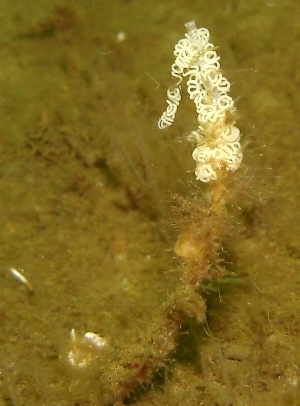
Concerning message #21924:
Hello Bill,
Since our first posting our observations re. Flabellina trophina on the tube worms back in 2004 [#12533 ], we have become a lot wiser. This, thanks to the SSF.
We believe that the correct interpretation of our observations is that we are seeing F. trophina on the tubeworm Spiochaetopterus costarum. F. trophina is not feeding on the tubeworm but rather on hydroids growing on the outside of the tubeworm. We have noted that where the animals have eaten and where they have laid their egg masses, the exterior of the tubeworm is grazed off. I hope this is possible to interpret from the photos.
Therefore, it is not "breaking any rules" as it is not feeding on the tubeworm but rather on hydroids on the outside of the worm.
Locality: Bear Cove, 40 feet, British Columbia, Pacific Ocean, 04 May 2007, Muddy. Length: 10 cm . Photographer: Jackie Hildering.
Jackie Hildering
earthlingenterprises@telus.net
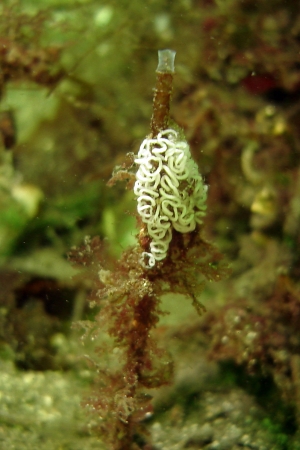
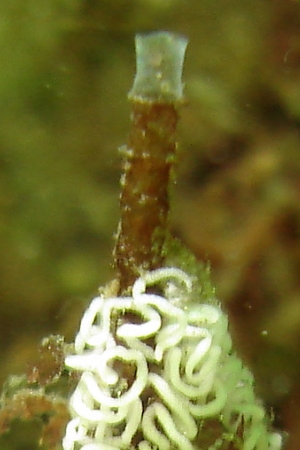
Dear Jackie,
Thanks for the follow up. As you will see from the other replies I have posted today, there now seems to be general agreement on the identity of the worm tubes. As Jeff Goddard mentions [#21936 ], Irina Roginskaya in an earlier message reports finding setae and parts of chaetopterid worms in the gut of specimens [#9702 ], which seem more than inadvertent 'bycatch'. The presence of the aeolid on the chateopterid worm tubes, and worm parts in their stomachs, would seem pretty good evidence that they eat the worms, at least as part of their diet. It would be nice to actually catch them eating a worm or some hydroids - or both - but I guess we can't have everything. I must admit the strange cone-like head-foot structure looks as though it is a modification for tube-dwelling and even tube-feeding. If that is so, feeding must be an interesting sight.
As to your suggestion that the clean tube at the top is evidence of them eating the hydroids, this is not necessarily so. Firstly, eolids tend to eat only the hydroid polyps so the dead 'stalks' would still be attached to the worm tube. And secondly, a more likely explanation for the clean part of the tube is that it is continually lengthening, and the clean part has not as yet been overgrown with epiphtyes and epizooids. Its also possible that the worms keep the end of their tubes clean.
Best wishes,
Bill Rudman
Flabellina trophina feeding and laying eggs
October 3, 2008
From: Marli Wakeling
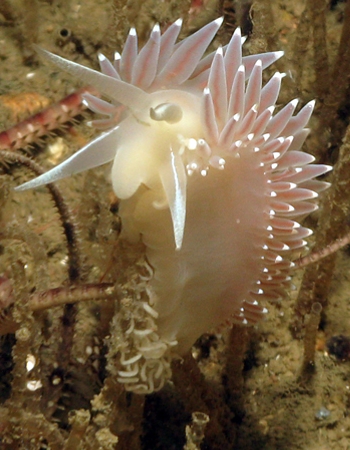
Concerning message #21914:
Hi Bill,
I thought I would send in this record of feeding for Flabellina trophina. There were many of them in a field of solitary hydroids (a Tubularia sp.), and they had reduced it to a field of stalks. Some were laying eggs on the remains of the hydroids.
Locality: Bowyer Island, Howe Sound, 45 feet, British Columbia, Pacific, 07 Sept 2008, Rock reef. Length: 20mm. Photographer: Marli Wakeling.
Cheers,
Marli Wakeling
scubamarli@gmail.com
Wakeling, M., 2008 (Oct 3) Flabellina trophina feeding and laying eggs. [Message in] Sea Slug Forum. Australian Museum, Sydney. Available from http://www.seaslugforum.net/find/21924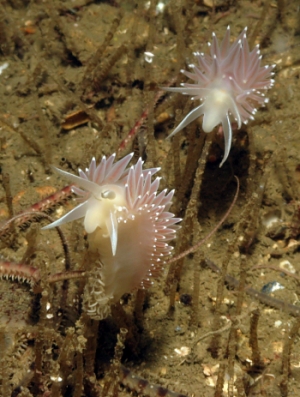
Dear Marli,
Thanks for these interesting photos. In an earlier message [#12533] Jackie Hildering & Glen Miller suggested they had photos showing this species feeding on tube worms. The tubes in your photos look very similar. My problem is that from photos alone we can't tell whether the tubes are worm tubes or hydroid tubes. When you say they were in a field of solitary hydroids, were there any tubes which still contained hydroids? Or is there some other way you can be sure these are hydroid tubes rather than worm tubes.
Best wishes,
Bill Rudman
Flabellina trophina or F. triophina ?
September 25, 2007
From: Daniel Hershman
Some sources describe Flabellina trophina as triophina. Is this just a typo that's been perpetuated throughout the literature?
Dan Hershman
dphershman@comcast.net
Hershman, D.P, 2007 (Sep 25) Flabellina trophina or F. triophina ?. [Message in] Sea Slug Forum. Australian Museum, Sydney. Available from http://www.seaslugforum.net/find/20795Dear Dan,
The correct spelling is trophina
Best wishes,
Bill Rudman
Re: Flabellina trophina - egg laying
July 9, 2007
From: Jackie Hildering & Glen Miller
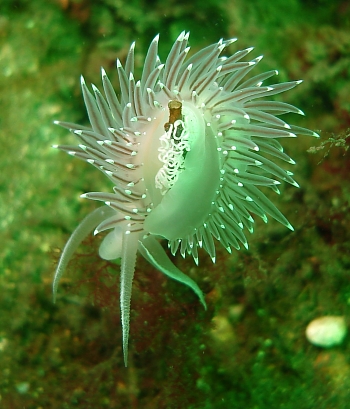
Concerning message #12536:
To follow-up on our March 26, 2004 posting on Flabellina trophina egg laying, thought this photo might be of interest. It shows an individual possibly just having laid its eggs.
Locality: Bear Cove, 39 feet, British Columbia, Canada, Pacific Ocean, 22 April 2007 , Silt bottom. Length: 7 cm . Photographer: Jackie Hildering.
Jackie Hildering & Glen Miller
earthlingenterprises@telus.net
Hildering, J. & Miller, G., 2007 (Jul 9) Re: Flabellina trophina - egg laying. [Message in] Sea Slug Forum. Australian Museum, Sydney. Available from http://www.seaslugforum.net/find/20126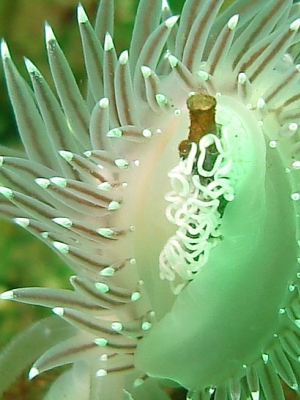
Dear Jackie and Glen,
Certainly looks promising
Best wishes,
Bill Rudman
Flabellina trophina from British Columbia
July 9, 2007
From: Marli Wakeling
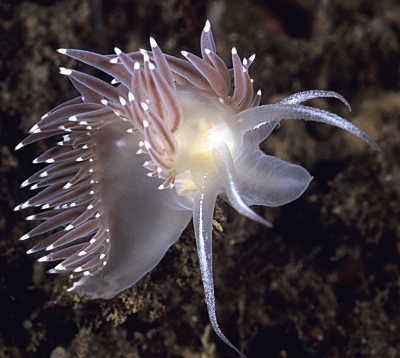
Hi Bill,
Thought I'd send this in, as prior messages have shown Flabellina trophina feeding on tube worms. I found this large specimen on the top of a hydroid, which I believe was Tubularia indivisa, or a similar species.
Locality: Agamemnon Channel, Sunshine Coast, 12 metres, British Columbia, Canada, Pacific, 18 Nov 2006, Rocky reef. Length: 55mm. Photographer: Marli Wakeling.
Cheers,
Marli Wakeling
scubamarli@gmail.com
Wakeling, M., 2007 (Jul 9) Flabellina trophina from British Columbia. [Message in] Sea Slug Forum. Australian Museum, Sydney. Available from http://www.seaslugforum.net/find/20113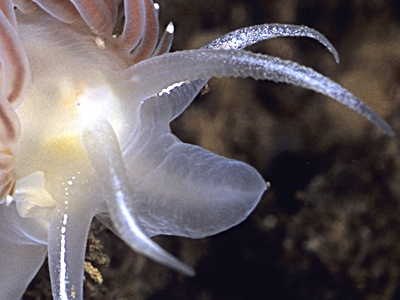
Hi Marli,
Thanks for sharing. Your main photo and Bill's close-up show the main characteristic that differentiates this species, the long pointed tube-like snout. Your photo even shows it upturned pose. Nice.
Your point about this species having been reported to feed on tubeworms is salient. We have only recently learned, as you point out, this aeolid is a cnidarian predator and feeds on hydroids that live on the tough tube of the worm. Not the worm itself.
Thanks again,
Dave Behrens
Re:Flabellina trophina ? from Japan
July 24, 2006
From: Yasuhiro Shamoto
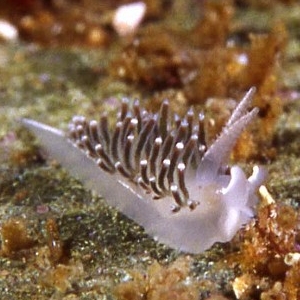
Dear Dr.Rudman.
Thank you for your comments [#17155 ].
Unfortunately this is the only other photo I have so I can't tell you more about the head. I can't say whether the brown clumps are tube worms.
Locality: Echizen coast, Fukui Pref, Japan, 5 m, 17 May 2006, on the stone. Length: approx 10 mm. Photographer: Yasuhiro Shamoto.
Yasuhiro Shamoto
yasunao515@cyber.ocn.ne.jp
Yasuhiro Shamoto, 2006 (Jul 24) Re:Flabellina trophina ? from Japan. [Message in] Sea Slug Forum. Australian Museum, Sydney. Available from http://www.seaslugforum.net/find/17190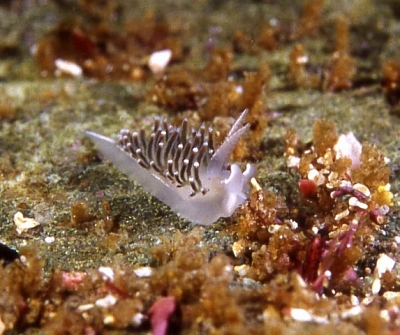
Dear Yasu,
Thanks for this extra photo. I suspect the brown clumps are groups of worm tubes, but it's hard to be sure.
Best wishes,
Bill Rudman
Flabellina trophina ? from Japan
July 19, 2006
From: Yasuhiro Shamoto
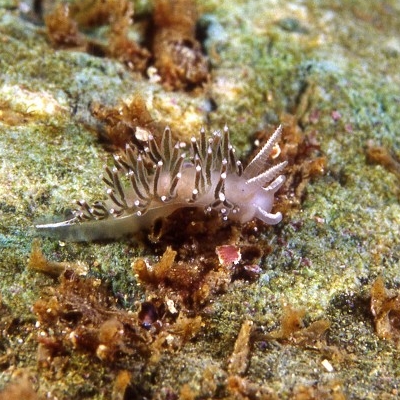
Hello, Dr.Rudman
I have found this animal at Echizen coast, Fukui Pref., Japan.
I think this is Flabellina trophina. I would be grateful for any comment.
Locality: Echizen-coast, Fukui-Pref, 5m, Japan, 17 May 2006, on the stone. Length: approx 10mm. Photographer: Yasuhiro Shamoto
Yours sincerely
Yasuhiro Shamoto
.
yasunao515@cyber.ocn.ne.jp
Yasuhiro Shamoto, 2006 (Jul 19) Flabellina trophina ? from Japan. [Message in] Sea Slug Forum. Australian Museum, Sydney. Available from http://www.seaslugforum.net/find/17155Dear Yasu,
It certainly looks quite like F. trophina, and since it is now known from the Russian coast, its presence in Japan would not be surprising. One thing that would be interesting to know is whether it has the strange 'snout-like' extension on the front of the head like we can see in a number of earlier messages [see top photo on Fact Sheet]. This seems to be unique to this species and is probably associated with its behaviour of feeding on tube worms. I have left quite a bit of the background in your photo because the brown clumps we can see all over the bottom look very like worm tubes, which could be another clue that this is F. trophina.
The snout on the head seems to be changeable in shape, but perhaps you have another photo which shows it better? And can you remember if the brown clumps were worm tubes or not?
Best wishes,
Bill Rudman
Re: Flabellina trophina - feeding on worms
July 10, 2004
From: Ron Velarde
Hi Bill, Jackie and Glen,
As I read your message [m12533], I was skeptical about them feeding on polychaete worms. My impression was that they were just crawling up the tubes looking for hydroids. In reviewing the other messages, I guess it is possible that they are going after the worms; and as you stated Bill, the only way to be sure would be to collect information on the food of several individuals and see if they are in fact feeding on the worms. Or someone could do some feeding studies in the laboratory and see if they feed on polychaetes. We definately need more observations to confirm that polychaete worms are food and not just an accidental intake.
As to the identity of the polychaete worms, I doubt that they are Diopatra ornata. This species adheres sand, gravel, shell debris, algae and anything else it can find to the exposed portion of the tubes that it builds. The tubes in the photos are free of attached debris. In fact, they look just like Spiochaetopterus tubes, as was reported in earlier messages! Also, Diopatra has large powerful jaws and I am sure it would protect itself from a nudibranch trying to munch on it from the opening to it's tube.
Hope this adds a little more to this interesting relationship.
Ron Velarde
rvelarde@sandiego.gov
Velarde, R., 2004 (Jul 10) Re: Flabellina trophina - feeding on worms. [Message in] Sea Slug Forum. Australian Museum, Sydney. Available from http://www.seaslugforum.net/find/12559Thanks Ron,
Bill Rudman
Flabellina trophina - feeding on worms [1]
March 26, 2004
From: J. Hildering and G. Miller
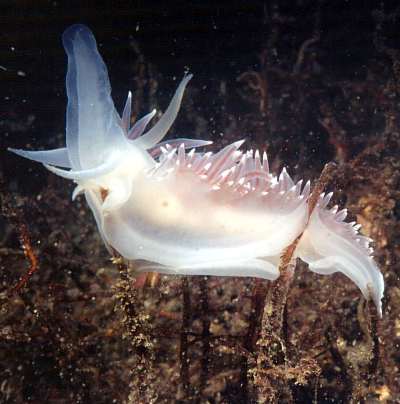
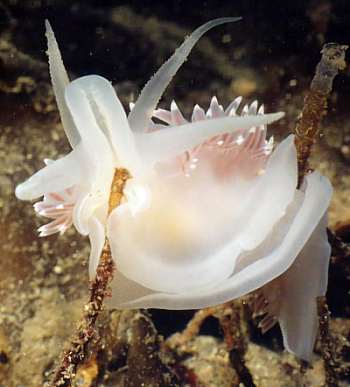
Hello Dr. Rudman,
The continuing story of Flabellina trophina:
We had posted a message last February that generated some very interesting discussion and have attempted to get more photographic evidence of its feeding and breeding behaviour [message #9542]. I carefully propose that F. trophina is both feeding and laying eggs on the tube worm I believe to be Diopatra ornata. Further feedback would be very much valued.
It is amazing how there are tens of these animals wrapped completely around the tubeworm. It several images, they also appear to be extending their mouth-parts over the top of the tube. I am sending 6 images of what I think is feeding behaviour and will follow with 3 pictures relating to reproduction [#12536].
Dive: Bear Cove, Northern Vancouver Island, British Columbia, Canada
Depth: 40'
Photographer: Glen Miller
Date: March 21st, 2004
Many thanks,
Jackie Hildering & Glen Miller
earthent@telus.net
Hildering, J. & Miller, G., 2004 (Mar 26) Flabellina trophina - feeding on worms [1]. [Message in] Sea Slug Forum. Australian Museum, Sydney. Available from http://www.seaslugforum.net/find/12533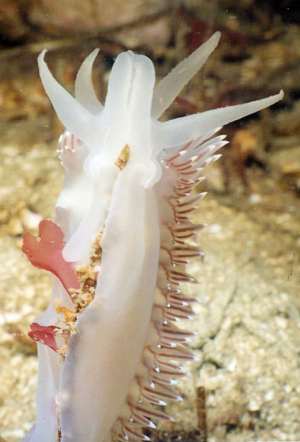
Dear Jackie & Glen,
These are wonderful photos. There seems little doubt that these animals are feeding on the tube worms - although a look for polychaete remains in the stomach would be the only way to remove any doubts. I don't quite understand the purpose of the tubular oral veil, which is unique to this species. From your photos the mouth seems to be at the level of the tip of the worm tube with the tubular oral veil projecting upwards. Perhaps, as suggested by Irina Roginskaya, [message #9702] this structure is used, not in situations where the aeolid can climb up the worm tube, but in cases where the aeolid is crawling on the sand and the oral veil can be used to pull the tip of a shorter worm tube down to the mouth.
Because these photos illustrate such a unique phenomenon I have included 3 more in a separate message [#12534].
Best wishes,
Bill Rudman
Flabellina trophina - feeding on worms [2]
March 26, 2004
From: J. Hildering and G. Miller
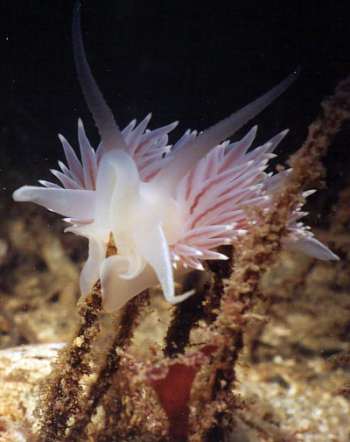
Here are 3 more photos of Flabellina trophina feeding on the tube worm Diopatra to accompany my other message [#12533].
Dive: Bear Cove, Northern Vancouver Island, British Columbia, Canada
Depth: 40'
Photographer: Glen Miller
Date: March 21st, 2004
Jackie Hildering & Glen Miller
earthent@telus.net
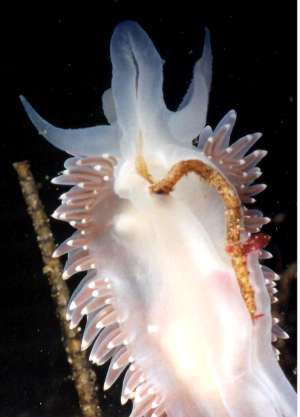
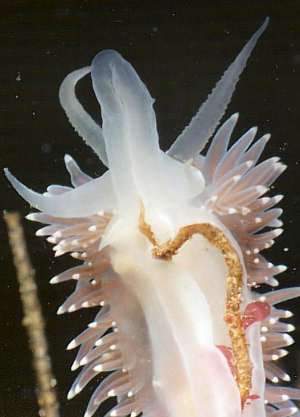
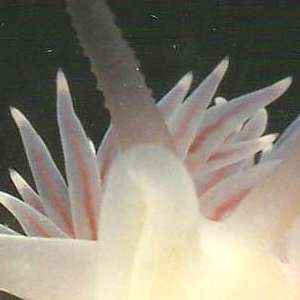
Thanks Jackie & Glen,
One feature I can't see described in the literature is the presence of the cnidosac, the sac at the tip of the cerata of cnidarian feeding aeolids in which nematocysts are stored. I can't see any sign of it in your photos but it could be small and hidden beneath the white tip. If it is absent, or very reduced in size, it would be another sign that these animals do not feed on cnidarians
Best wishes
Bill Rudman
Flabellina trophina - egg laying
March 26, 2004
From: J. Hildering and G. Miller
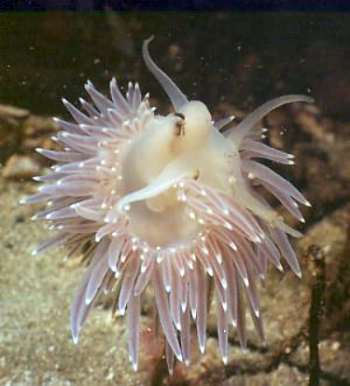
Dear Bill,
In a continued effort to understand the behaviour of Flabellina trophina, I also include these images of the positioning of the eggs atop the tube worm. In the second image, it appears the animal has just finished laying the eggs and is moving away.
Again, any insights into this intriguing species would be very much valued.
Dive: Bear Cove, Northern Vancouver Island, British Columbia, Canada
Depth: 40'
Photographer: Glen Miller
Date: March 21st, 2004
Jackie Hildering & Glen Miller
earthent@telus.net
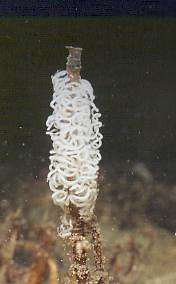
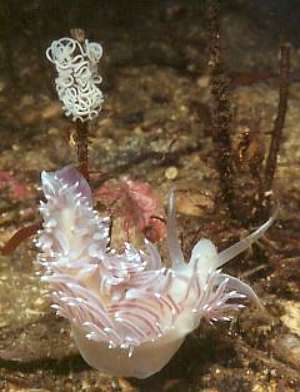
Dear Jackie & Glen,
Your photos are so self-explanatory that there is little I can offer in the way of a a commentary. Many nudibranchs, and most aeolids, lay their eggs on or adjacent to their food. Although this species apparently no longer feeds on hydroids, it seems to have continued the 'tradition' of laying its eggs on its food.
Best wishes
Bill Rudman
'Coryphella' trophina and its feeding habits
April 18, 2003
From: Irina Roginskaya
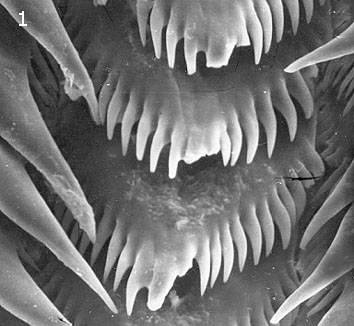
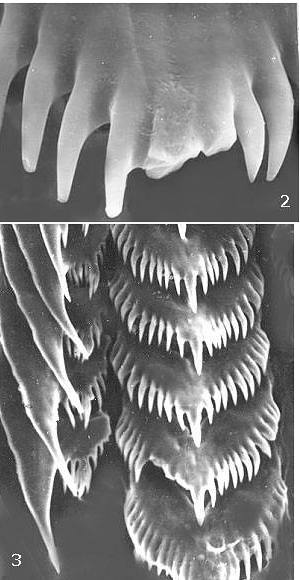
The revision of literature data concerning four coryphellids from the North Pacific : Coryphella sp. Bergh,1879 (the single bulbus pharyngeus collected near Adakh Island, Aleutians), Coryphella trophina Bergh, 1894 (Port Althorp, Alaska), Coryphella fusca O'Donoghue,1921 (Vancouver Island region) and Aeolis camchatica Volodchenko,1941 (Avatcha Bay, East Kamchatka) led me to the conclusion on conspecifity of these species. Accordingly Coryphella sp., C. fusca and Aeolis camchatica are to be regarded as junior synonyms of Coryphella trophina [see Roginskaya, 1986, 1990]. I persist in considering Coryphella as a taxon distinct from Flabellina.
The results I got from the study of the samples from the Sea of Okhotsk and from the Bering Sea added new details to the feeding habits of this species. My material included six specimens of C. trophina: one - from the Bering Sea (59 57'2"N, 169 40'5"E, R/V "Vytiaz". Depth 115m. 24 June 1952) and five - from the Sea of Okhotsk, collected by N.A.Zarenkov in May-June 1958/: 1 ex. from 56 11'N,154 50'E.Depth 88m; 3 ex. from 56 00'N, 155 7'30"E.Depth 69m; 1 ex. from 57 29'3"N, 156 46'0" E. Depth 20m.
The radular teeth of all the specimens of C. trophina examined displayed the great degree of splitting and obliteration I described earlier (Roginskaya, 1969), unusual for hydroid feeders. And the study of stomach contents of two animals from the sea of Okhotsk discovered, side by side with fragments of hydroids, the rather unusual food objects for Coryphella - the pharyngeal bulbs of small sized nudibranchs Cuthona sp. and Coryphella verrucosa. In the stomach of one specimen [body length 25.5 mm] the pharyngeal bulbs of swallowed nudibranchs numbered as much as 10 ! The significant number of pharyngeal bulbs in the stomach indicates that the unusual destruction of the radular teeth may be caused by the contact of the teeth with rather hard prey -the jaws and radulae of swallowed nudibranchs. It also suggets that this predatory mode of feeding is apparently not accidental, but normal for the species. It is interesting to recall the observation of Bergh in connection with this species from Aleutian Islands [Bergh, 1879]. He found hanging out of a 5mm long buccal bulb of Coryphella sp. "a fine 6mm long Caprella". It seems also that Coryphella trophina - common along the Pacific Coast of North America as C. fusca - has a reputation for being voracious molluscs. It is no mere chance that in the "Suggested draft list" of Common Names List of North American Marine Gastropods, Part 3, pp.17-25 , appeared in Shells and Sea Life, 1985, vol.17, no.1, the common name of C. fusca is designated as "predaceous aeolid".
Thanks to Sandra Millen, who kindly sent me three specimens of C. fusca from the Vancouver Island region I could study by SEM the radular ribbons of Canadian representatives of the species. And again the radular teeth displayed the significant morphological variety as well as strong damage and splitting. From the photos of the radular teeth enclosed [Figs 1-3] it is seen that the central and lateral radular teeth are strongly armed with long denticles. It is obvious that the most loading during the feeding process falls on the central tooth of the radula [Figs.1,2]. And these cusps demonstrate the most drastic damage [Fig. 2]. The stomach contents of these Canadian animals contained bristles, setae and large fragments of polychaetes belonging to the family Chaetopteridae - most probably Spiochaetopterus. It seems doubtful that C. trophina would be content with just gathering dead nudibranchs and polychaetes, that is being a scavenger, relying on dead animals. But to be sure, it would be good if anyone could observe in nature how C. trophina attacks the mobile nudibranchs and polychaetes it apparently feeds on.
It seems to me that the seizure of the prey can take place by means of the original anterior three-cornered "cephalic shield", placed between the oral tentacles and bearing the deep groove. This organ is clearly demonstrated in the photos posted in the message from Jackie Hildering and Glen Miller. It looks like the upper lip of the slug is expanded out into a tube. Working with this tube over the bottom, C. trophina could capture the thin tubes of Spiochaetopterus, sending them to the mouth and extracting the worm from its tube by the action of strong mandibles and radula. So it is really possible, that the specimens from British Columbia could be preying on tube worms such as Diopatra ornata?
References:
• Bergh, L.S.R., 1879. On the nudibranchiate gastropod Mollusca of the North Pacific Ocean, with special results of those of Alaska. Sci.Results of the Exploration of Alaska. I, (5): 127-135.
• O'Donoghue, C., 1921. Nudibranchiate mollusca from the Vancouver Island Region. Transactions of the Royal Canadian Institute, Toronto, 13(1): 147-209.
3.Roginskaya, I.S. 1964. A large-sized nudibranch mollusk Coryphella fusca O'Donoghue - predator of small nudibranch mollusks Coryphella rufibranchialis Johnson and Cuthona sp. Zoologicheskii Zhurnal, 43(11): 1717-1719.
• Roginskaya, I. S. (1969) Taxonomy and ecology of the nudibranch mollusc Coryphella fusca. Zoologicheskii Zhurnal, 48: 1614-1617.
• Roginskaya I.S., 1986. Reader Forum (Coryphella trophina). Shells and Sea Life, 18(1): 17-18.
• Roginskaya, I. S. (1990) Data of feeding, distribution and synonymy of Coryphella trophina (Bergh, 1894) (Nudibranchia: Gastropoda), pp. 47-57, 151-152, 156. In: A. P. Kuznetsov, [Ed.], Feeding and bioenergetics of marine bottom invertebrates. Academy of Sciences of the U.S.S.R., P. P. Shirshov Institute of Oceanology, Moscow, 162 pp. [In Russian].
Irina Roginskaya
irina7@hotmail.com
Dear Irina,
Thanks for your interesting information. Firstly I agree it would be fascinating to get some first-hand accounts of how this animal feeds. On the question of its name. Considering the extremely large denticles on the radular teeth I fully agree with your suggestion that C. fusca and H. trophina are synonyms. However I am following standard practice, with which I agree, in considering Coryphella to be a synonym of Flabellina. There is a continuum of character variation within this group and I feel that if we agree to 2 genera we would soon need to increase that to satisfy the other slight differences to be found in the group. I guess we can only agree to differ. I have left Coryphella trophina in your message, but for consistency will use Flabellina trophina elsewhere in the Forum.
Thanks again for your interesting contribution,
Bill Rudman
Flabellina fusca - behaviour
April 2, 2003
From: Jackie Hildering & Glen Miller

Dear Bill,
Having been blown out on multiple boat dives, we have had recent repeated dives on the Bear Cove shore dive [Feb 8th to March 29th 2003]. The abundance of Flabellina fusca has been striking and its various behaviours have now become very intriguing.
As seen in the upper image, 10s of this species are found wrapped around what may be ornate tube worms. They appear to be preying on the tube worms but loose clusters of eggs are found also found atop what we believe to be tubeworms, too.
Any insights?
Site: Bear Cove, Port Hardy, British Columbia, Canada. Depth: 30-40'. February 9th.
Photo: Glen Miller
Jackie Hildering
Glen Miller
earthent@telus.net
![]()
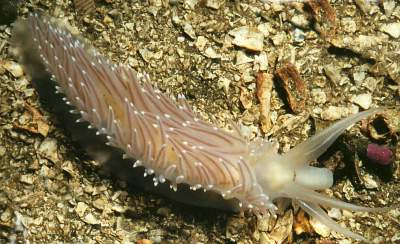
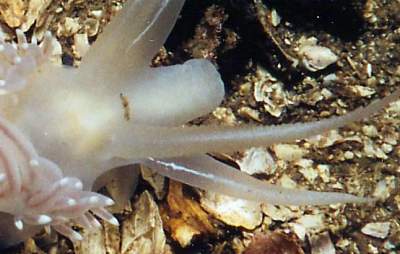
Renamed Flabellina trophina - see 18 April 2003 message.
Dear Jackie & Glen,
Thanks for the photos and the interesting observations. Perhaps Irina Roginskaya, who has studied this species in Russia, can give us her views. Waters, (1966) reports it feeding on a variety of hydroids [Obelia, Syncoryne, Bougainvillia], which is what you expect an aeolid to eat, but Roginskaya reports it being much more adventurous, feeding on other aeolids [1964 - Flabellina rufibranchialis, Cuthona sp, Hermissenda crassicornis] and the amphipod crustacea and polychaete worms [1990 - Caprella, ?Spiochaetopterus]. So it is possible that it is eating some tube worm. If you have a look at Marli's photo of egg ribbon you should be able to see if the eggs you have found on the worm tubes are the aeolid's. In your photo of it crawling on the shell sand the oral tube seems to be quite extended, suggesting it is quite interested in something in the sand - certainly not a hydroid colony. If you can catch it eating I would love to see a photo or two.
• Waters, Virginia L. 1966. Food preference and feeding behaviour of four nudibranchs. Annual Reports American Malacological Union, 1966: 63.
• Roginskaya, I. S. 1964. A large-sized nudibranch mollusc Coryphella fusca, O'Donoghue - predator of small nudibranch molluscs - Coryphella rufibranchialis Johnston and Cuthona sp. Zoologicheskii Zhurnal, 43(11): 1717-1719. [In Russian].
• Roginskaya, I. S. 1990. Data of feeding, distribution and synonymy of Coryphella trophina (Bergh, 1894) (Nudibranchia: Gastropoda), pp. 47-57, 151-152, 156. [In]: Feeding and bioenergetics of marine bottom invertebrates. Academy of Sciences of the U.S.S.R., P. P. Shirshov Institute of Oceanology, Moscow.
•Zack, S. 1975. A description and analysis of agonistic behavior patterns in an opisthobranch mollusc, Hermissenda crassicornis. Behaviour,53(3-4): 238-267.
Best wishes,
Bill Rudman
Flabellina fusca from Alaska
August 6, 2002
From: Clinton Bauder

Hi Bill,
I think this one is Flabellina fusca. It was taken at Coronation Island in Alaska at about 10m. July 2002. Size was maybe 50mm.
This dive was a pain in the neck - it was a steep wall facing the prevailing swell combined with the fact that it was covered in interesting nudibranchs, most of which were rather small. When you're moving up and down 10 feet at a time it's hard to get the camera pointed at a small subject! :-)
Clinton
gecko1@apple.com
Bauder, C., 2002 (Aug 6) Flabellina fusca from Alaska. [Message in] Sea Slug Forum. Australian Museum, Sydney. Available from http://www.seaslugforum.net/find/7686Renamed Flabellina trophina - see 18 April 2003 message.
Dear Clinton,
Nice photo - you obviously mastered the swell.
Bill Rudman
Flabellina fusca on egg mass from British Columbia
November 9, 2001
From: Marli Wakeling
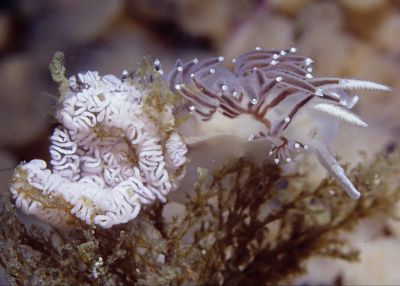
Hi Bill,
Further to the discussion re: the name of Flabellina fusca, here are several new photos of the species on eggs taken earlier this year.
Dive site: Renate's Reef, Barclay Sound, British Columbia, Canada.
Date: May 12, 2001
Depth: 15 meters
Length: 20 mm
Photographs: Marli Wakeling
Marli
scubamarli@excite.com
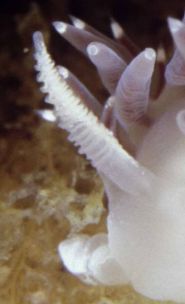
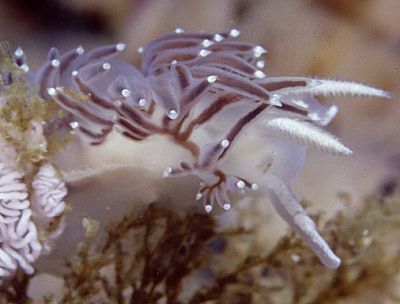
Renamed Flabellina trophina - see 18 April 2003 message.
Thanks Marli,
I am persisting with the name Flabellina fusca as I have not seen Irina Roginskaya's publications where she identifies it with Bergh's Himatella trophina. Any comments would be every welcome. It is not really necessary to be able to read Russian. The important thing is to read German and see what Bergh said about Himatella trophina. My understanding is that Bergh described this species from a preserved decolourised animal so it really depends whether the anatomical features described by Bergh are unique enough to identify his species with O'Donoghue's Flabellina fusca.
Best wishes,
Bill Rudman
Flabellina trophina or F. fusca?
October 17, 2001
From: Sandra Millen
Bill,
Concerning your query. Dr. Irene Roginskaya published on Coryphella fusca in 1964 and 1969 and in 1990 considered the species a junior synonym of Himatella trophina Bergh. The paper is in Russan with lots of radula illustrations including SEM photos. Sorry, I can't even translate the citation.
Sandra
millen@zoology.ubc.ca
Millen, S., 2001 (Oct 17) Flabellina trophina or F. fusca?. [Message in] Sea Slug Forum. Australian Museum, Sydney. Available from http://www.seaslugforum.net/find/5483Renamed Flabellina trophina - see 18 April 2003 message.
Thanks Sandra,
I have listed Irene Roginskaya's relevant papers below. I am inclined to agree with her synonymy. Before I do, I would appreciate any further comments from anyone familiar with these species.
• Roginskaya, I. S. (1986) Reader forum [Coryphella trophina]. Shells & Sea Life, 18(1): 17-18.
• Roginskaya, I. S. (1964) A large-sized nudibranch mollusc Coryphella fusca, O'Donoghue -- predator of small nudibranch molluscs -- Coryphella rufibranchialis Johnston and Cuthona sp. Zoologicheskii Zhurnal, 43(11): 1717-1719. [In Russian].
• Roginskaya, I. S. (1969) Taxonomy and ecology of the nudibranch mollusc Coryphella fusca. Zoologicheskii Zhurnal, 48: 1614-1617.
• Roginskaya, I. S. (1990) Data of feeding, distribution and synonymy of Coryphella trophina (Bergh, 1894) (Nudibranchia: Gastropoda), pp. 47-57, 151-152, 156. In: A. P. Kuznetsov, [Ed.], Feeding and bioenergetics of marine bottom invertebrates. Academy of Sciences of the U.S.S.R., P. P. Shirshov Institute of Oceanology, Moscow, 162 pp. [In Russian].
Best wishes,
Bill Rudman
Flabellina fusca or triopha?
October 15, 2001
From: Marli Wakeling
Hi Bill,
I was aware that Flabellina fusca was once named Coryphella fusca. However, I have just found a new marine life ID book that lists it as Flabellina triopha. Perhaps someone can clarify this.
Marli
scubamarli@excite.com
Wakeling, M., 2001 (Oct 15) Flabellina fusca or triopha?. [Message in] Sea Slug Forum. Australian Museum, Sydney. Available from http://www.seaslugforum.net/find/5466Renamed Flabellina trophina - see 18 April 2003 message.
Dear Marli,
Has the book no references? There was flabellinid described from Alaska by Bergh, Himatella trophina Bergh, 1894, but I don't know if anyone has decided the two are the same. Perhaps Sandra Millen can help us out
Cheers,
Bill Rudman
Flabellina fusca from British Columbia
February 21, 2001
From: Marli Wakeling
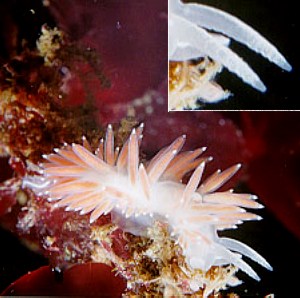
Here is another one of our more common aeolids, Flabellina fusca. It is very similar to Flabellina verrucosa, but has slightly annulated rhinophores (see enlargement). This was found in Howe Sound, near Vancouver, British Columbia, [Canada] at 40 feet. It is about 3 cm. long. The cerata colour varies between pink and reddish brown. In a separate message see a specimen that has similarities to both this and Flabellina verrucosa and Flabellina trilineata.
Marli
scubamarli@excite.com
Wakeling, M., 2001 (Feb 21) Flabellina fusca from British Columbia. [Message in] Sea Slug Forum. Australian Museum, Sydney. Available from http://www.seaslugforum.net/find/3822Renamed Flabellina trophina - see 18 April 2003 message.
Thanks Marli,
I can't find much published about this species at all. One point from O'Donoghue's original description is that he described the rhinophores as being perfoliate with up to 38 shallow leaves. From your photo, the 'leaves' are very shallow, but I would find it difficult to count more than 11 or 12 wrinkles. Any comments?
Bill Rudman
A colour variant of Flabellina fusca
February 21, 2001
From: Marli Wakeling
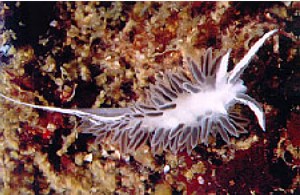
This is a strange looking Flabellina specimen. The colour is the darkest that I have seen. The usual white tips on the cerata aren't present, and the white on the oral tentacles is much more like a Flabellina verrucosa. However, the rhinophores are slightly annulate. There is also a white line running down the dorsal area, like a Flabellina trilineata. Sandra Millen felt it was indeed a Flabellina fusca, with strange colouration.
Marli
scubamarli@excite.com
Wakeling, M., 2001 (Feb 21) A colour variant of Flabellina fusca. [Message in] Sea Slug Forum. Australian Museum, Sydney. Available from http://www.seaslugforum.net/find/3826Renamed Flabellina trophina - see 18 April 2003 message.
Thanks Marli,
O'Donoghue (1921) in his original description talks of 'cores of the cerata are of a deep brown colour' which would seem to match this specimen quite well.
Bill Rudman
